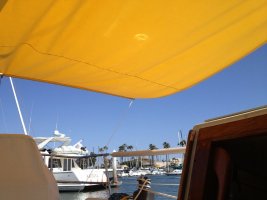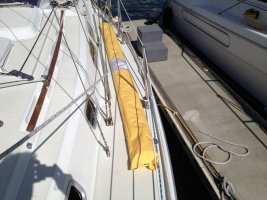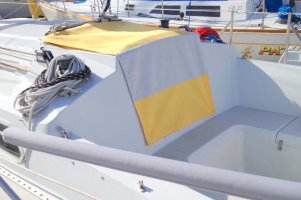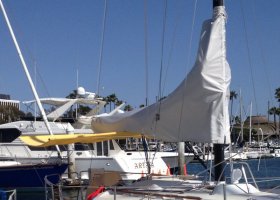Retired from newspapers and television, currently sailing Thelonious II, a 1984 Ericson 381.
When it comes to providing shade for the cockpit, a cover connecting a stern Bimini to a dodger is most popular here in Los Angeles. Many modern wide-bodied boats have both those appendages, which in order to provide walk-under space can begin to resemble a new cityscape in Dubai and give even a fairly sleek boat the profile of Kon-tiki. But it seems to me that the 32-3 is too small for a proper dodger, which would interfere with entry to the cockpit, and although the sun is strong in Southern California the breeze is usually cool, so maybe blotting out the view of the mainsail with a Bimini isn’t emphatically required. If you don’t need shade while sailing, a cockpit cover gets easy.
I measured for 10’x11’ of Sunbrella “sunflower” yellow. A four-inch hem at each end would contain a 10-foot spreader pole. The poles would connect to the mainsail block bail on the boom, and to the backstay. Simple enough. But did I need a pole in the center of the cover, too? Should the cover be also suspended in the middle by the main halyard? Would this design be baggy or floppy? My month’s worth of sewing experience suggested I quit worrying so much and fix problems later.
The fabric was 46” wide, which I joined with semi- flat-felled seams. The poles required a gap at fabric midpoint. I practiced folding and cutting the hole on scrap cloth, which was a good idea because my initial visualization was all wrong. Now, what for poles? I chose 1” pine rounds from Home Depot – hanger rods for closets. They’re cheap, stiff, and can hold hardware if necessary.
[Update, 2021]: On the E381, I now use 1.5" PVC spreader poles and they work well. Current cloth is Sunbrella Silver, because the sunflower gave an orangy cast to the cockpit in bright sun.
 ...
...

Also, I added simple end tapes with Velcro to keep the hems taut outboard.
At the fitting, worrying proved premature. With a line at each corner and the stiff closet poles tensioned, the cover was nice and flat. Forward lines tied horizontally to stays and aft lines down to cleats make it secure even in a crosswind. And there’s no need for side curtains, because the awning will pivot to the lifelines on either side.
 .
.
.
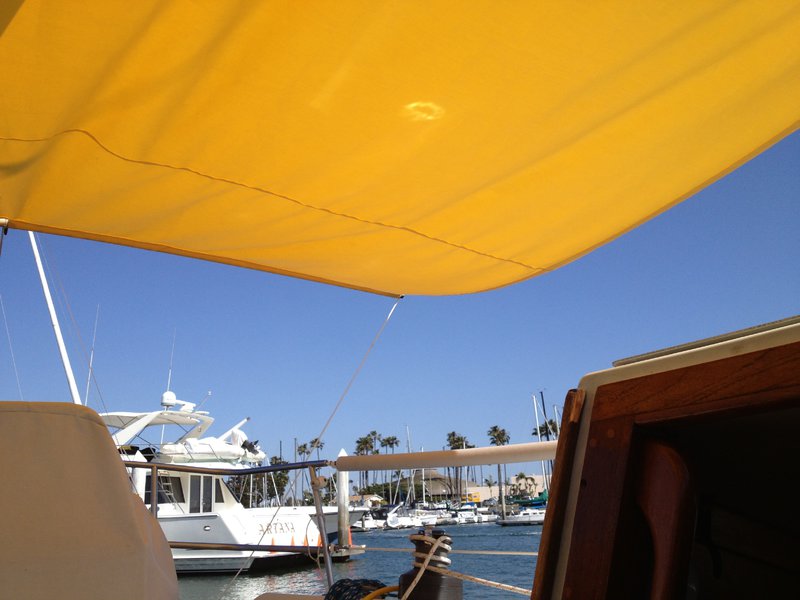
The cover rolls up tight on its poles, but it’s ten feet long. Where to store? On deck, in a bag made from left-over fabric. For day sails, we leave the bag on the dock. (I subsequently moved the bag to outside hangers on the foredeck stanchions.)

Most of the deep blue velour of the interior cushions on Thelonious was in good shape after 27 years, with the exception of the V-berth. There the UV from the uncovered forward hatch had destroyed the top panels to the point of crumbling. It turns out that the Sunbrella interior marine fabric called “Indigo Bubble” is a close match. I tediously seam-ripped apart the damaged covers and found I only had to replace the top and the front edge panels. The other panels were fine, even the original zippers.
I admit that the 90-degree turns of an inside-out new/old V-berth cover challenged my sewing machine skills at first. Double-sided seam tape was a useful aid. In any case, the interior material sews easily and the navy blue V-69 thread, lighter than the V-92, is invisible against the Indigo Bubble cloth.

By the way, I washed every interior cover twice in a home washing machine, using Tide detergent. I let them dry outside. There was no damage or shrinkage, and they came out smelling good. The many, many pieces of foam in the boat all got sun-dried and heavily sprayed with a mildew killer called Moldex. There wasn’t much mildew, but the several dark stains no longer smell like “boat.” With the cushions reinstalled, I treated the interior with two hour-long sessions of my powerful ion generator. That was six weeks ago and the boat still smells clean and fresh.
Using leftover Sunbrella “sunflower” and “silver” I made a companionway hatch cover in about two hours. Not strictly necessary, but it will protect the acrylic lid and the oiled teak hatch boards, and is a good example of small fabric projects I couldn’t have done a year ago. The photo also shows recovered stern lifeline cushions.
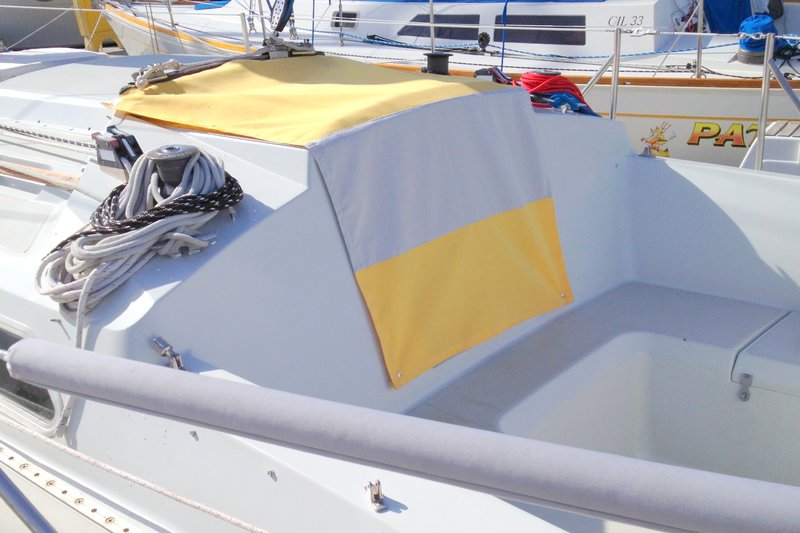
In fact, I’ve found a new ability to sew to be unexpectedly useful. Like many of us, I have a collection of ice bags – perhaps the most useful item in yachting, and the older the more the memories. Two were from the ‘70s, stained, battered, and reminiscent of summer days, young children, good times and several continents.The handles were worn out, so I just sewed new ones on. I find now I can repair boat shoes, belts, backpacks and nylon webbing – usually with the Speedy Stitcher Sewing Awl. I can hem my own pants, turning today’s gangbanger knee-length shorts back into actual Bermuda shorts. I have let out my own tuxedo pants, obviating the need to reveal to a tailor all too many recent helpings of linguini. I have hemmed curtains, repaired a fancy bicycle pack, manufactured several ditty bags, invented a pouch for a radar reflector so it can be carried disassembled on board, and I tell you without exaggeration that if you gave me the right materials and a day to think about it I could probably make you a damned pretty set of doilies and some lace underwear, too.
Am I become like unto a god? In modesty, that’s not for me to say. Or, in Ian Richardson’s refrain in the British original of “House of Cards”, “You might well think that, but I couldn’t possibly comment.”
Ah, Sewmanship. It changes you in so many ways.
Here is Part 4:
I measured for 10’x11’ of Sunbrella “sunflower” yellow. A four-inch hem at each end would contain a 10-foot spreader pole. The poles would connect to the mainsail block bail on the boom, and to the backstay. Simple enough. But did I need a pole in the center of the cover, too? Should the cover be also suspended in the middle by the main halyard? Would this design be baggy or floppy? My month’s worth of sewing experience suggested I quit worrying so much and fix problems later.
The fabric was 46” wide, which I joined with semi- flat-felled seams. The poles required a gap at fabric midpoint. I practiced folding and cutting the hole on scrap cloth, which was a good idea because my initial visualization was all wrong. Now, what for poles? I chose 1” pine rounds from Home Depot – hanger rods for closets. They’re cheap, stiff, and can hold hardware if necessary.
[Update, 2021]: On the E381, I now use 1.5" PVC spreader poles and they work well. Current cloth is Sunbrella Silver, because the sunflower gave an orangy cast to the cockpit in bright sun.
Also, I added simple end tapes with Velcro to keep the hems taut outboard.
At the fitting, worrying proved premature. With a line at each corner and the stiff closet poles tensioned, the cover was nice and flat. Forward lines tied horizontally to stays and aft lines down to cleats make it secure even in a crosswind. And there’s no need for side curtains, because the awning will pivot to the lifelines on either side.

.

The cover rolls up tight on its poles, but it’s ten feet long. Where to store? On deck, in a bag made from left-over fabric. For day sails, we leave the bag on the dock. (I subsequently moved the bag to outside hangers on the foredeck stanchions.)

Most of the deep blue velour of the interior cushions on Thelonious was in good shape after 27 years, with the exception of the V-berth. There the UV from the uncovered forward hatch had destroyed the top panels to the point of crumbling. It turns out that the Sunbrella interior marine fabric called “Indigo Bubble” is a close match. I tediously seam-ripped apart the damaged covers and found I only had to replace the top and the front edge panels. The other panels were fine, even the original zippers.
I admit that the 90-degree turns of an inside-out new/old V-berth cover challenged my sewing machine skills at first. Double-sided seam tape was a useful aid. In any case, the interior material sews easily and the navy blue V-69 thread, lighter than the V-92, is invisible against the Indigo Bubble cloth.

By the way, I washed every interior cover twice in a home washing machine, using Tide detergent. I let them dry outside. There was no damage or shrinkage, and they came out smelling good. The many, many pieces of foam in the boat all got sun-dried and heavily sprayed with a mildew killer called Moldex. There wasn’t much mildew, but the several dark stains no longer smell like “boat.” With the cushions reinstalled, I treated the interior with two hour-long sessions of my powerful ion generator. That was six weeks ago and the boat still smells clean and fresh.
Using leftover Sunbrella “sunflower” and “silver” I made a companionway hatch cover in about two hours. Not strictly necessary, but it will protect the acrylic lid and the oiled teak hatch boards, and is a good example of small fabric projects I couldn’t have done a year ago. The photo also shows recovered stern lifeline cushions.

In fact, I’ve found a new ability to sew to be unexpectedly useful. Like many of us, I have a collection of ice bags – perhaps the most useful item in yachting, and the older the more the memories. Two were from the ‘70s, stained, battered, and reminiscent of summer days, young children, good times and several continents.The handles were worn out, so I just sewed new ones on. I find now I can repair boat shoes, belts, backpacks and nylon webbing – usually with the Speedy Stitcher Sewing Awl. I can hem my own pants, turning today’s gangbanger knee-length shorts back into actual Bermuda shorts. I have let out my own tuxedo pants, obviating the need to reveal to a tailor all too many recent helpings of linguini. I have hemmed curtains, repaired a fancy bicycle pack, manufactured several ditty bags, invented a pouch for a radar reflector so it can be carried disassembled on board, and I tell you without exaggeration that if you gave me the right materials and a day to think about it I could probably make you a damned pretty set of doilies and some lace underwear, too.
Am I become like unto a god? In modesty, that’s not for me to say. Or, in Ian Richardson’s refrain in the British original of “House of Cards”, “You might well think that, but I couldn’t possibly comment.”
Ah, Sewmanship. It changes you in so many ways.
Here is Part 4:

